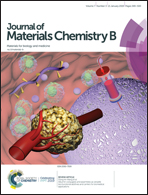Development of a red-light emission hypoxia-sensitive two-photon fluorescent probe for in vivo nitroreductase imaging†
Abstract
The overexpression of nitroreductase (NTR) in hypoxia has been recognized as a biomarker of highly aggressive disease, and the development of a hypoxia-sensitive two-photon (TP) bioimaging probe with both excitation and emission wavelengths in the red-light region provides favorable deep-tissue imaging with a low background fluorescence signal. Although quite a few TP hypoxia-sensitive fluorescent probes have been reported for NTR detection, their short emission wavelength (<550 nm) limits their application. Herein, we report a red light emissive TP hypoxia-sensitive turn-on probe (NRP) by employing Nile Red as a red-emitting fluorophore and p-nitrobenzene as an NTR recognition group with improved sensitivity. The NRP probe showed obvious strong red-fluorescence enhancement in the presence of NTR and high selectivity toward NTR in aqueous solution. Our in vitro experimental results illustrated that the NRP loaded tumor cells treated under hypoxia display remarkably strong fluorescence in both OP and TP microscopy at 655 nm with 45-fold enhancement, which affords deep-tissue penetration ability. The NRP probe was also successfully applied for imaging NTR in liver tissue slices and a 4T1-bearing mice model, which is important for bioimaging applications.



 Please wait while we load your content...
Please wait while we load your content...